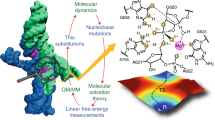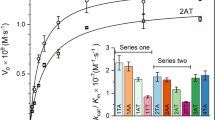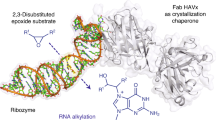Abstract
Active site guanines are critical for self-cleavage reactions of several ribozymes, but their precise functions in catalysis are unclear. To learn whether protonated or deprotonated forms of guanine predominate in the active site, microscopic pKa values were determined for ionization of 8-azaguanosine substituted for G8 in the active site of a fully functional hairpin ribozyme in order to determine microscopic pKa values for 8-azaguanine deprotonation from the pH dependence of fluorescence. Microscopic pKa values above 9 for deprotonation of 8-azaguanine in the active site were about 3 units higher than apparent pKa values determined from the pH dependence of self-cleavage kinetics. Thus, the increase in activity with increasing pH does not correlate with deprotonation of G8, and most of G8 is protonated at neutral pH. These results do not exclude a role in proton transfer, but a simple interpretation is that G8 functions in the protonated form, perhaps by donating hydrogen bonds.
This is a preview of subscription content, access via your institution
Access options
Subscribe to this journal
Receive 12 print issues and online access
$259.00 per year
only $21.58 per issue
Buy this article
- Purchase on Springer Link
- Instant access to full article PDF
Prices may be subject to local taxes which are calculated during checkout




Similar content being viewed by others
Accession codes
References
Hampel, A. & Cowan, J.A. A unique mechanism for RNA catalysis: the role of metal cofactors in hairpin ribozyme cleavage. Chem. Biol. 4, 513–517 (1997).
Nesbitt, S., Hegg, L.A. & Fedor, M.J. An unusual pH-independent and metal-ion-independent mechanism for hairpin ribozyme catalysis. Chem. Biol. 4, 619–630 (1997).
Young, K.J., Gill, F. & Grasby, J.A. Metal ions play a passive role in the hairpin ribozyme catalysed reaction. Nucleic Acids Res. 25, 3760–3766 (1997).
Murray, J.B., Seyhan, A.A., Walter, N.G., Burke, J.M. & Scott, W.G. The hammerhead, hairpin and VS ribozymes are catalytically proficient in monovalent cations alone. Chem. Biol. 5, 587–595 (1998).
Beringer, M. & Rodnina, M.V. The ribosomal peptidyl transferase. Mol. Cell 26, 311–321 (2007).
Cochrane, J.C. & Strobel, S.A. Catalytic strategies of self-cleaving ribozymes. Acc. Chem. Res. 41, 1027–1035 (2008).
Fedor, M. Comparative enzymology and structural biology of RNA self-cleavage. Annu. Rev. Biophys. 38, 271–299 (2009).
van Tol, H., Buzayan, J.M., Feldstein, P.A., Eckstein, F. & Bruening, G. Two autolytic processing reactions of a satellite RNA proceed with inversion of configuration. Nucleic Acids Res. 18, 1971–1975 (1990).
Rupert, P.B., Massey, A.P., Sigurdsson, S.T. & Ferré-D'Amaré, A.R. Transition state stabilization by a catalytic RNA. Science 298, 1421–1424 (2002).
Torelli, A.T., Krucinska, J. & Wedekind, J.E. A comparison of vanadate to a 2′-5′ linkage at the active site of a small ribozyme suggests a role for water in transition-state stabilization. RNA 13, 1052–1070 (2007).
Rupert, P.B. & Ferré-D'Amaré, A.R. Crystal structure of a hairpin ribozyme-inhibitor complex with implications for catalysis. Nature 410, 780–786 (2001).
Martick, M. & Scott, W.G. Tertiary contacts distant from the active site prime a ribozyme for catalysis. Cell 126, 309–320 (2006).
Klein, D.J. & Ferré-D'Amaré, A.R. Structural basis of glmS ribozyme activation by glucosamine-6-phosphate. Science 313, 1752–1756 (2006).
Cochrane, J.C., Lipchock, S.V. & Strobel, S.A. Structural investigation of the GlmS ribozyme bound to its catalytic cofactor. Chem. Biol. 14, 97–105 (2007).
Bevilacqua, P.C. Mechanistic considerations for general acid-base catalysis by RNA: revisiting the mechanism of the hairpin ribozyme. Biochemistry 42, 2259–2265 (2003).
Pinard, R. et al. Functional involvement of G8 in the hairpin ribozyme cleavage mechanism. EMBO J. 20, 6434–6442 (2001).
Fedor, M.J. & Williamson, J.R. The catalytic diversity of RNAs. Nat. Rev. Mol. Cell Biol. 6, 399–412 (2005).
Knobloch, B., Sigel, H., Okruszek, A. & Sigel, R.K. Acid-base properties of the nucleic-acid model 2′-deoxyguanylyl(5′ → 3′)-2′-deoxy-5′-guanylate, d(pGpG)3-, and of related guanine derivatives. Org. Biomol. Chem. 4, 1085–1090 (2006).
Puglisi, J.D., Wyatt, J.R. & Tinoco, I. Jr . Solution conformation of an RNA hairpin loop. Biochemistry 29, 4215–4226 (1990).
Lupták, A., Ferré-D'Amaré, A.R., Zhou, K., Zilm, K.W. & Doudna, J.A. Direct pKa measurement of the active-site cytosine in a genomic hepatitis delta virus ribozyme. J. Am. Chem. Soc. 123, 8447–8452 (2001).
Cai, Z. & Tinoco, I. Jr . Solution structure of loop A from the hairpin ribozyme from tobacco ringspot virus satellite. Biochemistry 35, 6026–6036 (1996).
Ravindranathan, S., Butcher, S. & Feigon, J. Adenine protonation in domain B of the hairpin ribozyme. Biochemistry 39, 16026–16032 (2000).
Gong, B. et al. Direct measurement of a pKa near neutrality for the catalytic cytosine in the genomic HDV ribozyme using Raman crystallography. J. Am. Chem. Soc. 129, 13335–13342 (2007).
Wierzchowski, J., Wielgus-Kutrowska, B. & Shugar, D. Fluorescence emission properties of 8-azapurines and their nucleosides, and application to the kinetics of the reverse synthetic reaction of purine nucleoside phosphorylase. Biochim. Biophys. Acta 1290, 9–17 (1996).
Da Costa, C.P., Fedor, M.J. & Scott, L.G. 8-Azaguanine reporter of purine ionization states in structured RNAs. J. Am. Chem. Soc. 129, 3426–3432 (2007).
Fedor, M.J. Tertiary structure stabilization promotes hairpin ribozyme ligation. Biochemistry 38, 11040–11050 (1999).
Joseph, S., Berzal-Herranz, A., Chowrira, B.M. & Burke, J.M. Substrate selection rules for the hairpin ribozyme determined by in vitro selection, mutation, and analysis of mismatched substrates. Genes Dev. 7, 130–138 (1993).
Anderson, P. et al. Mutagenesis of the hairpin ribozyme. Nucleic Acids Res. 22, 1096–1100 (1994).
Kuzmin, Y.I., Da Costa, C.P. & Fedor, M.J. Role of an active site guanine in hairpin ribozyme catalysis probed by exogenous nucleobase rescue. J. Mol. Biol. 340, 233–251 (2004).
Kuzmin, Y.I., DaCosta, C.P., Cottrell, J. & Fedor, M.J. Contribution of an active site adenosine to hairpin ribozyme catalysis. J. Mol. Biol. 349, 989–1010 (2005).
Nesbitt, S.M., Erlacher, H.A. & Fedor, M.J. The internal equilibrium of the hairpin ribozyme: temperature, ion and pH effects. J. Mol. Biol. 286, 1009–1024 (1999).
Lebruska, L.L., Kuzmine, I.I. & Fedor, M.J. Rescue of an abasic hairpin ribozyme by cationic nucleobases. Evidence for a novel mechanism of RNA catalysis. Chem. Biol. 9, 465–473 (2002).
Jencks, W.P. General acid-base catalysis. in Catalysis in Chemistry and Enzymology 163–242 (Dover Publications, Inc., New York, 1969).
Da Costa, C.P. & Sigel, H. Acid-base and metal ion binding properties of guanylyl(3′ → 5′)guanosine (GpG-) and 2′-deoxyguanylyl(3′ → 5′)-2′-deoxyguanosine [d(GpG)-] in aqueous solution. Inorg. Chem. 42, 3475–3482 (2003).
Sigel, H. & Griesser, R. Nucleoside 5′-triphosphates: self-association, acid-base, and metal ion-binding properties in solution. Chem. Soc. Rev. 34, 875–900 (2005).
Nakano, S., Chadalavada, D.M. & Bevilacqua, P.C. General acid-base catalysis in the mechanism of a hepatitis delta virus ribozyme. Science 287, 1493–1497 (2000).
Nakano, S., Proctor, D.J. & Bevilacqua, P.C. Mechanistic characterization of the HDV genomic ribozyme: assessing the catalytic and structural contributions of divalent metal ions within a multichannel reaction mechanism. Biochemistry 40, 12022–12038 (2001).
Park, H. & Lee, S. Role of solvent dynamics in stabilizing the transition state of RNA hydrolysis by hairpin ribozyme. J. Chem. Theory Comput. 2, 858–862 (2006).
Rhodes, M.M., Reblova, K., Sponer, J. & Walter, N.G. Trapped water molecules are essential to structural dynamics and function of a ribozyme. Proc. Natl. Acad. Sci. USA 103, 13380–13385 (2006).
Salter, J., Krucinska, J., Alam, S., Grum-Tokars, V. & Wedekind, J.E. Water in the active site of an all-RNA hairpin ribozyme and effects of Gua8 base variants on the geometry of phosphoryl transfer. Biochemistry 45, 686–700 (2006).
Walter, N.G. Ribozyme catalysis revisited: is water involved? Mol. Cell 28, 923–929 (2007).
Nam, K., Gao, J. & York, D.M. Electrostatic interactions in the hairpin ribozyme account for the majority of the rate acceleration without chemical participation by nucleobases. RNA 14, 1501–1507 (2008).
Milligan, J.F. & Uhlenbeck, O.C. Synthesis of small RNAs using T7 RNA polymerase. Methods Enzymol. 180, 51–62 (1989).
Johnson, I. Fluorescent probes for living cells. Histochem. J. 30, 123–140 (1998).
Virta, P. et al. Synthesis, characterisation and theoretical calculations of 2,6-diaminopurine etheno derivatives. Org. Biomol. Chem. 3, 2924–2929 (2005).
DeLano, W.L. The PyMOL Molecular Graphics System (DeLano Scientific LLC, San Carlos, California, USA, 2004).
Acknowledgements
We thank the Fedor lab for help with manuscript preparation. This work was supported by US National Institutes of Health grant GM046422 and by a postdoctoral fellowship provided by the Skaggs Institute for Chemical Biology to L.L.
Author information
Authors and Affiliations
Contributions
L.L., J.W.C. and M.J.F. designed the experiments, interpreted the results and prepared the manuscript. L.G.S. synthesized 8azaGTP and developed methods for using 8azaGTP in transcription reactions. L.L. and J.W.C. prepared the RNAs and carried out self-cleavage and fluorescence assays.
Corresponding author
Supplementary information
Supplementary Text and Figures
Supplementary Figures 1 and 2, and Supplementary Methods (PDF 208 kb)
Rights and permissions
About this article
Cite this article
Liu, L., Cottrell, J., Scott, L. et al. Direct measurement of the ionization state of an essential guanine in the hairpin ribozyme. Nat Chem Biol 5, 351–357 (2009). https://doi.org/10.1038/nchembio.156
Received:
Accepted:
Published:
Issue Date:
DOI: https://doi.org/10.1038/nchembio.156
This article is cited by
-
An NMR and DFT investigation on the interconversion of 9-substituented-N 6 -hydrazone-8-azaadenine derivatives: proton migration or conformational isomerization?
Structural Chemistry (2018)
-
Pressure modulates the self-cleavage step of the hairpin ribozyme
Nature Communications (2017)
-
Structural basis for activity of highly efficient RNA mimics of green fluorescent protein
Nature Structural & Molecular Biology (2014)



